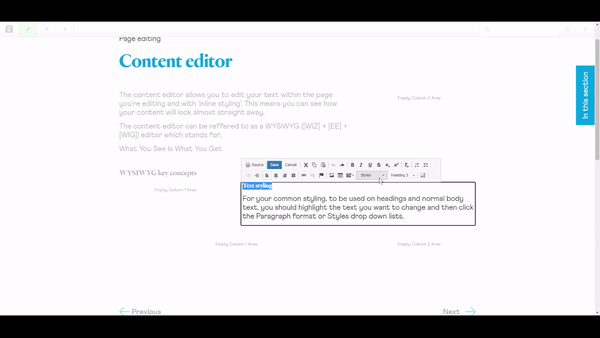Page editing
Content editor
The content editor allows you to edit your text within the page you're editing and with "inline styling". This means you can see how your content will look almost straight away.
The content editor can be referred to as a WYSIWYG ([WIZ] + [EE] + [WIG]) editor which stands for:
What You See Is What You Get
WYSIWYG key concepts
Text styling
All content will be automatically styled with a "normal" or paragraph style. If you need to change the style of text you can use Headings or Styles.
Headings
To create a heading, select the text with your mouse and then choose the relevent heading from the list (Heading 1 to 6). Your text will change in size and colour depending on the pre-defined stylesheet.
Heading styles
Heading styles range from Heading 1 (most important) to Heading 6 (least important). Headings are titles or subtitles used to structure content in a symantic framework.
Search engines use the headings to index the structure and content of your web pages.
Users often skim a page by its headings. It is important to use headings to show the document structure.
H1 headings should be used for main headings, followed by H2 headings, then the less important H3, and so on.
Custom styles
We create custom styles for each website to allow additional control of the look and feel of your content.
You may require a specific style for statistics or certain button types and links. These are all found within the "Styles" dropdown list and can be applied by selecting the text and choosing from the dropdown list.
Some custom styles, such as buttons, are only visible once you have created the link. So build your link first, then click the link and select a style from the dropdown list.

WYSIWYG editor buttons

Top row
(left to right)
Source – View HTML source code of the content
Save – Saves your changes
Cancel – Cancels any changes
Scissors – Cut
Copy – Copies content
Paste – Pastes content
Undo – Reverses changes
Redo – Implements the previous change
Bold – Adds bold font weight to content
Italic – Changes content to italic font style
Underline – Adds an underline
Strikethrough – Applies strikethrough to content
Subscript – Useful for H20, etc.
Superscript – Useful for m2 or footnotes, etc.
Remove formatting
Number list
Bullet list
Bottom row
(left to right)
Outdent
Indent
Align left
Align centre
Align right
Justify content
Link
Remove link
Page anchor
Image
Table builder
Element viewer
Styles (Custom styles)
Normal (Headings, etc.)
Element viewer